Key Takeaways
- General biology challenges many first-year students with a new technical language, foreign concepts and massive amounts of content, threatening their progress toward completing college.
- BioBook, an interactive e-text designed for non-majors biology courses, relies on a Root-Branch-Leaf node structure that organizes content knowledge and provides a study-test-study-test pattern of learning.
- Tools embedded in BioBook give students multiple ways to engage with the content and instructors multiple ways to evaluate student progress before failure occurs.
- Designed to develop in an iterative fashion, BioBook will also have a price designed for sustainability without imposing financial burdens on students.
BioBook aims to create deeper student learning and engagement, with the goal of improving persistence and success in general biology — a barrier to graduation for many students. General biology can be extremely challenging because it combines a new technical language, foreign concepts, and massive amounts of content. Unfortunately, many students face this hurdle in their first year, in classes too large to provide individual instruction.
An interactive e-text, BioBook relies on a simple yet powerful node structure that both organizes content knowledge and provides a scaffold for assisting novice learners. Using this node structure, students follow different paths as they explore and interact with new knowledge Students can approach topics in the way that makes sense to them, rather than the order dictated by textbook authors. BioBook also teaches students how to learn using a pattern of study-test-study-test that can produce greater learning gains in nearly any topic area.
Addressing Learning Principles with a Root-Branch-Leaf Structure
To develop BioBook, we built a multidisciplinary team at Wake Forest University that includes expertise in biology (Dan Johnson), biophysics (Jed Macosko), and learning sciences (Kristin Redington Bennett), plus our technology partner, Odigia. This team planned and designed BioBook in the winter of 2010 in anticipation of the February 2011 Next Generation Learning Challenges (NGLC) grant proposal deadline. In April 2011 our team was notified that we received a Wave I grant to create a tool to combat students' barriers to learning in general biology. We had only three months to work with Odigia, who provided the platform, did the programming to solidify the design of the tools, revised wireframes, and added biology content. We successfully rolled out the pilot version of BioBook in late August 2011 and are currently collecting data and analytics on its implementation with 12 instructors and over 300 students at four regional institutions.
Figure 1 shows the overall structure of BioBook. Our intent is to help students engage with the material, reach the learning goals, and consistently check their understanding with self-tests and by posing questions to other students and to their instructors. With the BioBook model, students and instructors can identify problems before failure occurs.
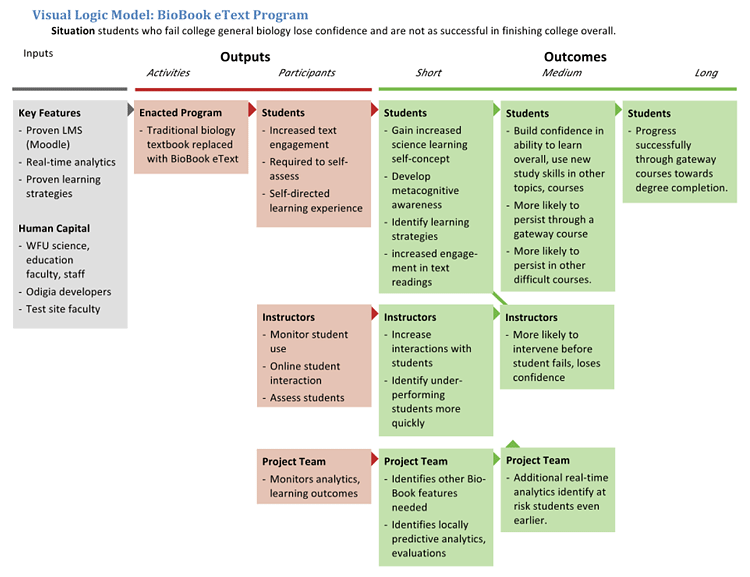
Figure 1. The BioBook Model
We started by considering the findings of the National Research Council report How People Learn.1 The report sets out six central principles of learning that helped us understand more specifically why the predominant textbook structure does not work for novice learners in STEM disciplines:
- Principle 1: Deep learning physically changes the brain. To accomplish this, learners must actively engage with new information, preferably via multiple sensory modalities.
- Principle 2: New information is difficult to learn unless it builds on and connects to prior knowledge.
- Principle 3: Each learner constructs their conceptual understanding by a different path.
- Principle 4: Frequent informal feedback promotes deeper and more accurate learning.
- Principle 5: Conscious awareness of one's own learning process improves the outcome.
- Principle 6: Learning is reinforced when students work and learn collaboratively.
To fully address these principles, we gave BioBook a Root-Branch-Leaf (node) structure, presenting small chunks of digestible information in a nonlinear way. The Root contains the broadest topic of information accessible; in our first version, students learn the main processes cells use to store and transmit information. The Branches break down the Root topic into areas of focus for study (for example, Cellular Life Cycle: Mitosis), and each Leaf provides the content to explain the Branch topic (such as, How does a dividing cell ensure DNA is equally divided between its two daughter cells?). Students can access the information contained in each Leaf when they need it, in the way that best suits their learning style. Figure 2 shows an example of the approach. The Root page divides into multiple Branches focused on specific topics, with each Branch supported by multiple Leaf pages that provide the actual content students need to learn. The video following Figure 2 explains BioBook's structure.
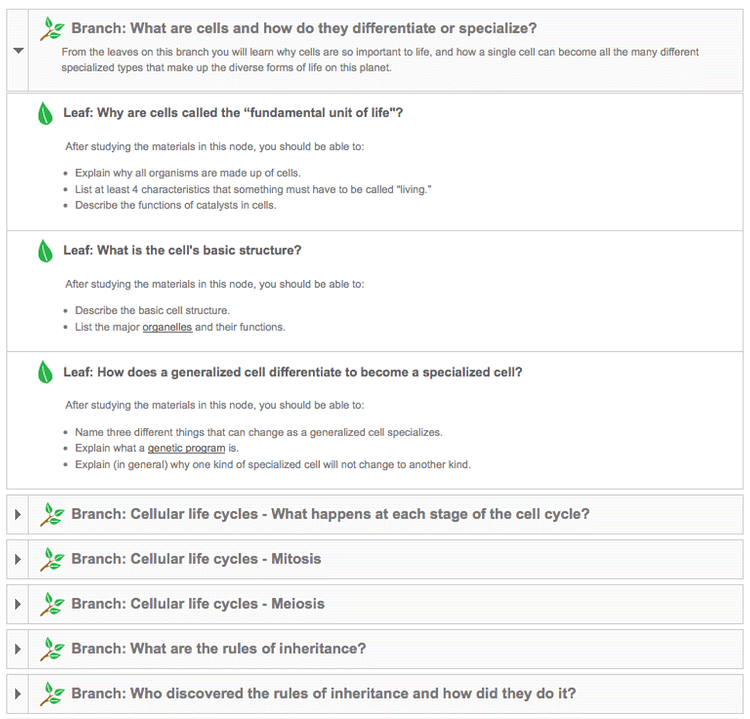
Figure 2. BioBook Root Pages, Multiple Branches, and Supporting Leaves
To learn more about BioBook's structure, see the video tutorial (3.58 minutes):
Embracing All Styles of Learning with Multimedia
To engage students' different learning styles and promote higher-order thinking, we offer multiple modes of presentation in each Leaf. In addition to traditional text, the Leaves incorporate engaging artwork, short video representations of biological processes, audio podcasts, and connections to the real world through news articles that relate to the field of biology. Leaves contain the content in BioBook and allow students to access all of the extras or track back to other areas of focus (see Figure 3 and the following video tutorial).
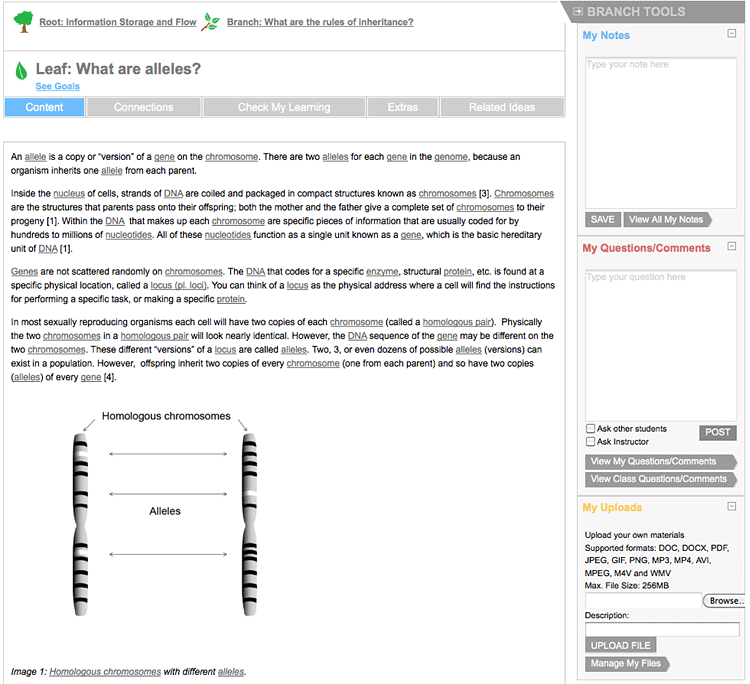
Figure 3. Leaves in BioBook
To learn more about the Leaves, see the video tutorial (1:56 minutes):
The array of tools in BioBook allows students to deepen learning at every node:
- Check My Learning: Students can access these brief quizzes multiple times until they are comfortable with their level of understanding (Figure 4). These self-assessments encourage students to understand material before moving on. Analytics accessed by the instructor offer the opportunity to structure the course, while in progress, based on students' understanding.
- Connections and Extras: These add depth to the Leaf content by providing videos, web pages, animations, and other ways to receive the basic information. As learning deepens, students can create connections across branches and leaves — evidence that the student is interacting with and understanding the content, and not just absorbing it.
- Social Media: As they use BioBook, students can ask questions of the instructor and other students at any time, extending the classroom experience beyond the confines of a lecture hall (see Figure 4, lower right).
- Note-taking: The Branch tools allow students to type notes in a window beside the content (Figure 4, middle right). These notes are individual (only available to the student) and stored "in the cloud," meaning they can be accessed at any time the student has Internet access.
- Progress Map: The instructor sets recommended reading progress, and the software monitors and reports the student's progress in comparison to this recommendation and the progress of other students in the course (Figure 4, upper right).
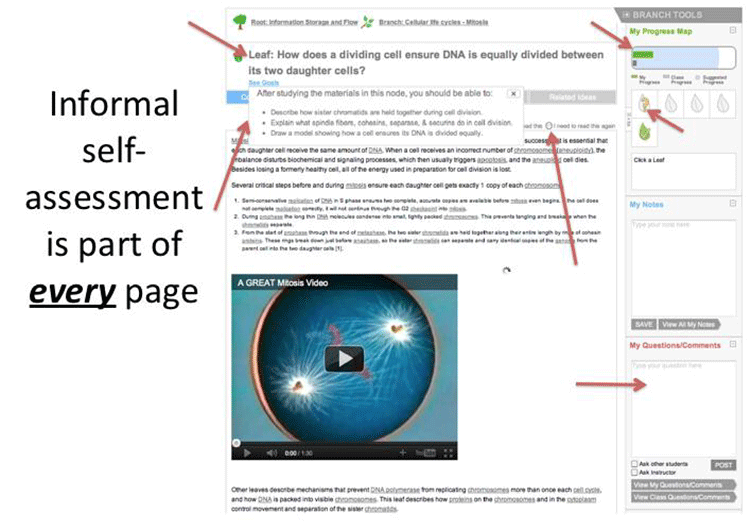
Figure 4. Self-Assessments and Other Tools in BioBook
To learn about all of BioBook's supplemental features, see the video tutorial (4:36 minutes):
Tailoring Lessons Using Analytics
Odigia has created a platform that allows instructors to collect analytics on persistence, or time spent on each page; understanding, using assessment data; and the ability to relate these reports to demographic data including identifiers for at-risk students. Instructors can track analytics by class or individual student at the Branch or Leaf level (see Figure 5).
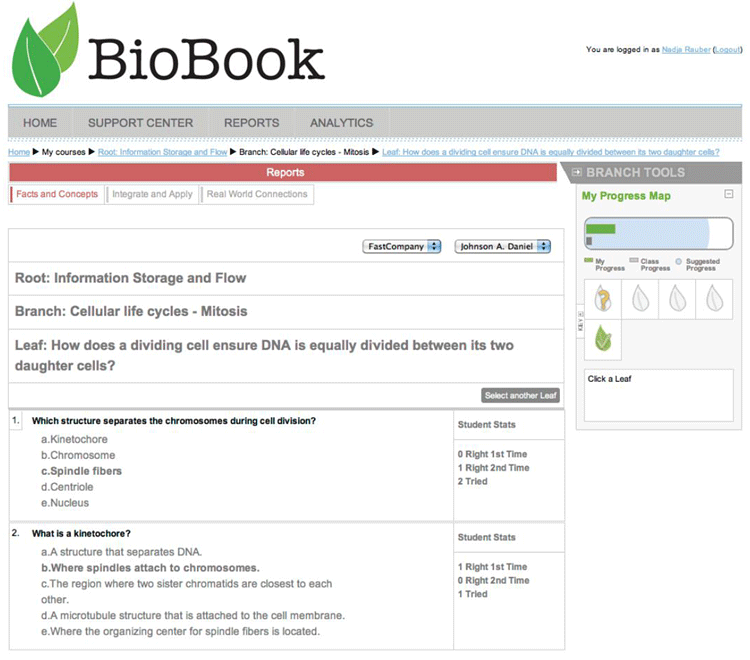
Figure 5. Analytics at the Branch or Leaf level
Using these analytics, instructors can tailor lectures to reflect the progress and understanding of an entire class, or they can provide individual instruction to struggling students — for example, suggesting specific Leafs and extras for a student to review. Indeed, one instructor using the tool reported, "Being able to see which concepts my students are missing in the fact and recall section helps me to know where to spend time teaching."
To learn more about instructor tools, see the video tutorial (4:51 minutes):
The initial responses by instructors have been very positive. Our early semester training sessions for instructors often doubled in planned length because instructors were enthusiastically suggesting course implementation ideas, additional content topics, and other tools. Students have also embraced the tools:
"The real-world connections help me study for the exam in a better way than I would think if I were just quizzing myself."
"I think the smaller amounts of information help me to digest what feels like a foreign language."
"I like that my textbook is really anywhere that I have an Internet connection."
Eliminating Barriers to Success
Part of the NGLC grant proposal included the requirement to develop a business model that was sustainable after the initial project completion. We plan to organize an open-source consortium and create a low-profit/nonprofit business model in which payment covers bandwidth, administrative costs, and development of additional tools and resources. The price we plan initially for BioBook — $60, when the typical non-majors textbook costs more than $150 — is based on the average cost of an e-text from a commercial publisher. We also expect it will eliminate or reduce cost barriers to textbook purchase, which is frequently an issue with financially strained or at-risk students.
Although most non-majors don't read (or even buy) their science texts, our field tests show that BioBook engages students in a way that textbooks never have. Our initial feedback gives us hope that we have created a tool that will lead to fewer non-majors dropping out of biology, which is a required course for graduation. This feedback also shows promise that our Root-Branch-Leaf structure could succeed in other academic disciplines.
Our goal is to have a final non-majors e-textbook ready for semester-long evaluation or adoption by August 2012. We intentionally planned for BioBook to mature through an iterative process, so we expect development to continue for as long as students continue to use it. At the same time, while students and instructors test BioBook at Wake Forest, and 3 other regional institutions, we are gathering qualitative data on the tools and their effectiveness, the content, and the benefits and challenges of implementing BioBook. All of this information will fold into new versions of BioBook as we evaluate its effectiveness in removing barriers to students' success in general biology courses.
- Committee on Developments in the Science of Learning, with additional material from the Committee on Learning Research and Educational Practice, National Research Council, How People Learn: Brain, Mind, Experience, and School, John D. Bransford, Ann L. Brown, and Rodney L. Cocking, eds. (Washington, DC: National Academies Press, 2000).
© 2011 Kristin Redington Bennett and A. Daniel Johnson. The text of this EQ article is licensed under the Creative Commons Attribution-Noncommercial-Share Alike 3.0 license.
